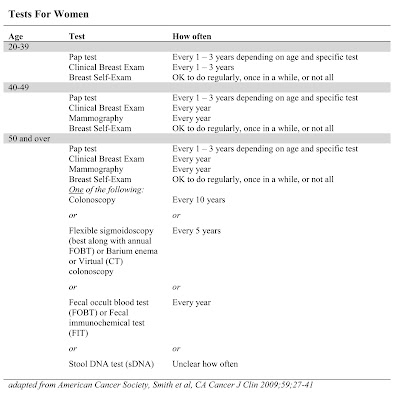Along with flowering plants , green grass, and warmer temperatures, late spring always brings with it a slew of cancer-related headlines out of the annual meeting of the American Society of Clinical Oncology (ASCO). This meeting is one of high points of the year for sharing the latest findings related to treatment, diagnosis, and sometimes even prevention of cancer, with thousands of studies presented during the course of the conference. With so many results and so much media coverage of the meeting, though, the context of certain findings can suffer amidst all the excitement and the reporting.
One of the perennial hot topics of the ASCO meeting is cancer screening, so we put together a primer on what makes an effective screening test and which tests for cancer are currently backed by solid science.
Effective screening allows for the prevention or early detection of cancer. Several factors are necessary for disease screening to be beneficial. First, the cancer being screened for must have a pre-symptomatic phase in which detection by screening increases the potential for preventing the cancer or more effectively treating it. Second, a simple, relatively inexpensive, and generally acceptable test with good accuracy (high sensitivity and specificity) has to be available. Third, the test must be done correctly, interpreted correctly, and be linked to any appropriate follow-up care – such as follow-up tests, more frequent screenings, or treatment. Most importantly, the test must be shown to reduce mortality from the disease.
Unfortunately, we don’t have screening tests that meet all these criteria for the majority of cancers. But effective screening is available for a number of important cancers, including colon, breast, cervix, and prostate. For cervix, the screening test identifies pre-malignant changes in the cells of the cervix, which can be treated to prevent the progression to invasive cancer. For colon, the benign polyps from which cancers arise can be detected and removed – again interrupting the progress toward invasive cancer.
Even when screening tests exist, they often go underused. A media post by GE shows just how much mammography use varies around the world (link). This innovative summary shows data from the developed world for screening, mortality from breast cancer and survival for women diagnosed with breast cancer. Many factors may contribute to variation in use of screening tests, but international data show just how much this use can vary. For example, fewer than 50 percent of women in France have had a up to date mammographic screening. In the Netherlands, the percentage is just under 90 percent.
Screening rates for different tests and in different populations vary greatly. For example, 80-90 percent of women in the US over the age of 18 have had a Pap test within the past 3 years, but only 72% of women over the age of 40 have had a mammogram in the past year. Screening rates for colon cancer are even lower; about 50 percent of adults 50 and older have had a colonoscopy or flexible sigmoidoscopy within the last 5 years or a fecal occult blood test in the past year. Underutilization may reflect both lack of access and lack of awareness. In fact, for colon cancer screening, even with Medicare coverage, rates of screening increase with higher levels of education.
Screening recommendations tend to vary from organization to organization and are often based on evidence and/or expert opinion. The most trustworthy recommendations come from the rigorous evidence-based US Preventive Services Task Force (USPSTF) screening guidelines, in addition to the guidelines provided by other well-respected organizations, such as the American Cancer Society.
As we hear of new tests being developed for less common cancers, the important tradeoffs must all be addressed before we move to widespread use. Importantly, as screening tests move toward detecting less common cancers, then the chance of a test incorrectly finding a suspicious result increases rapidly. Such “false positives” mean many women will be told that they may have cancer when in fact they do not. Not only does this cause a great deal of mental anxiety, the unnecessary follow up tests can be physical and fiscal burdens as well.
Cancer screening saves lives. That much is clear. But it only does so if the tests are appropriate, people actually get them done, and then have appropriate follow-up afterward.
It’s easy to fall into the draw of news headlines promoting “new,” “simple,” “accurate,” and “ground breaking” screening tests, but the truth is that most of the “new” screening tests that make it into the headlines ultimately fall short of meeting the necessary criteria for effectiveness and actually reducing mortality. Certainly, there’s room for more effective screening tests in the fight against cancer, but the science has to back up the hype of any new test before it’s put into widespread use.
For the most up-to-date screening guidelines, see the following websites:
US Preventive Services Task Force
General cancer screening recommendations in brief:
(Click to enlarge)

